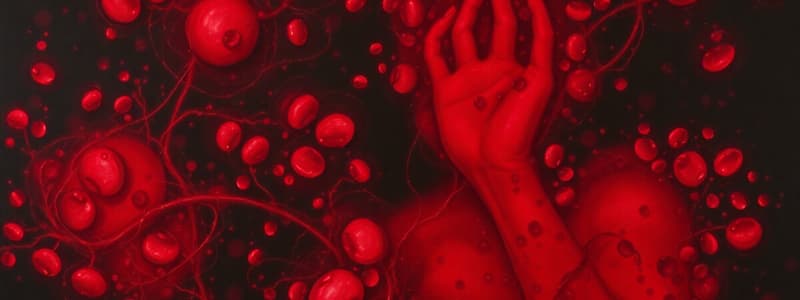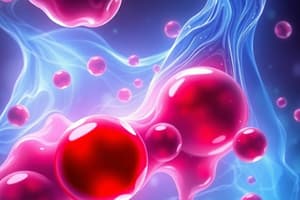Podcast
Questions and Answers
What is the primary function of erythrocytes?
What is the primary function of erythrocytes?
- Blood coagulation
- Immune response modulation
- Nutrient absorption
- Oxygen and carbon dioxide transport (correct)
Which of the following states the normal hematocrit values for males?
Which of the following states the normal hematocrit values for males?
- 30-40%
- 40-50% (correct)
- 35-45%
- 45-55%
What characterizes macrocytes in erythrocyte disorders?
What characterizes macrocytes in erythrocyte disorders?
- Increased hemoglobin content
- Diameter greater than 9 micrometers (correct)
- Diameter less than 6 micrometers
- Normal size with no abnormalities
Which component of the erythrocyte membrane provides flexibility?
Which component of the erythrocyte membrane provides flexibility?
What condition is characterized by a decrease in both the number and size of erythrocytes?
What condition is characterized by a decrease in both the number and size of erythrocytes?
What is the typical lifespan of a red blood cell?
What is the typical lifespan of a red blood cell?
In which layer of a centrifuged blood sample are the packed red blood cells found?
In which layer of a centrifuged blood sample are the packed red blood cells found?
What is the primary function of erythrocytes in the blood?
What is the primary function of erythrocytes in the blood?
What is the composition of plasma primarily made of?
What is the composition of plasma primarily made of?
Which of the following statements best describes the structure of mature erythrocytes?
Which of the following statements best describes the structure of mature erythrocytes?
Which plasma protein is primarily involved in blood coagulation?
Which plasma protein is primarily involved in blood coagulation?
In the preparation of blood smears, which component is primarily visualized?
In the preparation of blood smears, which component is primarily visualized?
Which type of blood cell constitutes the majority of formed elements in blood?
Which type of blood cell constitutes the majority of formed elements in blood?
What is the primary purpose of performing a bone marrow biopsy?
What is the primary purpose of performing a bone marrow biopsy?
Which of the following best describes the acidity of normal blood?
Which of the following best describes the acidity of normal blood?
Flashcards are hidden until you start studying
Study Notes
Blood
- Blood is a sticky red fluid that circulates in a closed system
- It has a volume of 5.5 liters and a pH of 7.4
- It is composed of plasma and formed elements
- Plasma is the liquid portion of blood
- Formed elements include red blood cells, white blood cells, and platelets
Functions of Blood
- Blood is important for transporting substances, regulating body conditions, and protecting the body
- It transports gases, nutrients, waste products, hormones, electrolytes, and more
- It regulates pH, osmotic pressure, and body temperature
- It provides protection and immunity
- It facilitates clot formation
Liquid Part of Blood
- Plasma is the liquid portion of blood
- It is composed of 91% water, 7-8% proteins, and 1% electrolytes, glucose, gases, and other substances
- Plasma proteins include albumin, globulins, fibrinogen, lipoproteins, and prothrombin
Blood Cells = Formed elements
- Blood cells are called formed elements
- Red blood cells (erythrocytes) make up 95% of formed elements
- White blood cells (leukocytes) make up 5% of formed elements
- Platelets (thrombocytes) are also formed elements
- Leukocytes can be further categorized into granulocytes (neutrophils, eosinophils, basophils) and agranulocytes (lymphocytes, monocytes)
Study of Blood Cells & Bone Marrow
- Blood cells are studied using smears or films
- Smears are prepared by spreading a drop of blood on a slide, drying, and fixing with alcohol
- The smears are then stained with Giemsa, Wright's, or Leishman's stains to visualize cell nuclei and cytoplasmic granules
- Bone marrow samples are obtained from the iliac crest and stained with Hematoxylin & Eosin (H&E)
Blood Smear Preparation
- Blood smears and bone marrow sections help visualize the structure and characteristics of blood cells under a microscope
Erythrocytes (Red Blood Cells = Red Blood Corpuscles = RBCs)
- Erythrocytes are biconcave, anucleate discs with a central pallor
- They are 7-7.5 micrometers in size
- They develop from pro-erythrocytes in the bone marrow
- They have a lifespan of about 120 days
- They are removed by macrophages in the spleen, liver, and bone marrow
- There are normally 4-6 million RBCs per microliter of blood
Structure of RBCs
- Red blood cells do not have nuclei or organelles
- They contain normal adult hemoglobin (HbA)
- They are flexible to accommodate small capillaries
- They are surrounded by a cell membrane composed of phospholipids, cholesterol, glycolipids, proteins, and carbohydrates
- The erythrocyte membrane contains a protein called spectrin
Spectrin
- Spectrin supports the erythrocyte membrane
- It provides flexibility to the membrane
Function of RBCs:
- RBCs are responsible for transporting oxygen and carbon dioxide for gas exchange
Hematocrit Value
- Hematocrit is a clinical test that measures the volume of packed red blood cells in a blood sample
- It is determined by centrifuging a heparinized blood sample
- The hematocrit value is represented by the basal layer of packed red blood cells after centrifugation
- The normal hematocrit range is 40-50% for males and 35-45% for females
Disorders of RBCs
- Anemia is a condition characterized by decreased numbers or size of erythrocytes, or reduced hemoglobin content in the blood
- Erythrocytosis and polycythemia involve an increased number of erythrocytes
- Macrocytes are erythrocytes with diameters greater than 9 micrometers, often caused by folic acid or vitamin B12 deficiency
- Microcytes have diameters less than 6 micrometers and are commonly associated with iron deficiency
- Aplastic Anemia is characterized by bone marrow failure
- Hemolytic Anemia is caused by inherited genetic alterations in RBCs or autoimmune conditions
- Reticulocytosis is an increase in the number of reticulocytes in blood due to rapid blood loss, normally 0.5-1.5%
- Poikilocytosis involves an increase in the number of distorted RBCs
Studying That Suits You
Use AI to generate personalized quizzes and flashcards to suit your learning preferences.




